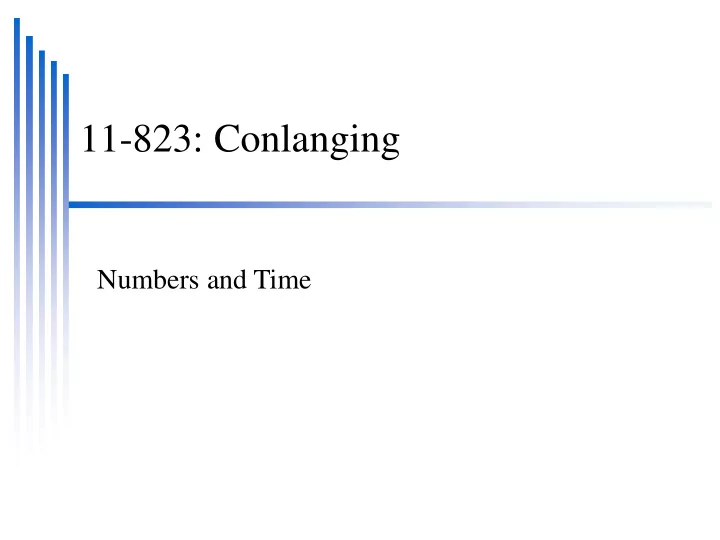

11-823: Conlanging Numbers and Time
Numbers and Time Counting – Speech and Orthography Clocks – Representing time – (and Calendars) Building prompts for telling the time
Numbers Counting (English) – One, two, three … – Ten, eleven, twelve – Thirteen, fourteen, … – Twenty, thirty, forty, ...
Numbers Counting (French) – Un, deux, trois, … – Dix, onze, douze, .. seize, – Dix-sept, dix-huit, dix-neuf – Vingt, trente, … – Quatre-vingt, quatre-vingt-dix
Numbers Counting (Roman/Latin) – I II III IV V VI VII VIII IX X – X XI XII … XIX – XL – MMXIV – Unus, duo, tres, quattuor, quinque, sex, septem, octo, novem, decem – Duedecem, viginti duo – But they conjugate
Numbers Counting (Chinese) – 一 二 三 四 五 六 七 八 九 十 – 十一 十四 – 二十 二十五
Numbers Counting (Japanese) – 一 二 三 四 五 六 七 八 九 十 – Ichi ni san shi/yon go roku shichi/nana hachi kyuu ju – But counting things – Hitotsu, futatsu, mittsu, yotsu, itsutsu, mutsu, nanatsu, yatsu, kokonotsu, tou – But varies with shape/size of objects – -mai (flat things), tou (large animals) hiki (small animals), satsu (books) hon (long round things) ...
Numbers Counting (English again) – Cardinal: one, two, three – Ordinal: first, second, third, ... – Adverbial: once, twice, thrice, quince – Cardinal prefix: uni-, bi-, tri-, quad- ... – Counters (cf Japanese) • Volumes (books), head (cattle), barrels (oil), sheets (paper/flat things), ...
Numbers General 1, 2, (3) might irregular 11, 12 might be irregular 11-19 might be irregular 5 based, 10 based (20 based) Might use “minus” e.g. IX Might have superstitious name changes Etymology often goes to older language – (i.e. numbers are long term, stable and for geeks)
Numbers base Base 10, or not … 4 gills in an ounce 16 ounces in a pound 14 pounds in a stone 8 stone in a hundredweight (112lb) 20 hundredweight in a ton Different people/professions use different magnitudes of measures
Numbers base 12 inches in a foot 3 feet in a yard 22 yards in a chain 10 chains in a furlong 8 furlongs in a fortnight
Numbers base 12 inches in a foot 3 feet in a yard 22 yards in a chain 10 chains in a furlong 8 furlongs in a mile Depends on the required accuracy: astronomical units, light years, ...
Numbers + Zero Negative numbers Fractions are common, decimals are later 50% 5 分 half Transcendental Numbers: Pi e i
Time Key notions – Sunrise, Sunset, noon – Solstices and equinoxes – Quarterdays (Lady Day and Michaelmas) (for taxes) – Mo(o)nths 月 (from Sanskrit ?) Years (365.25ish days) – Kings, Empires, start of time – Stardate (Star Trek, Julian Days)
Years/Calendar Often Lunar based – Becomes out of sync with seasons Julian Calendar/Gregorian Calendar – Pope Gregory 1582 – England (and her colonies) changed • 2nd September 1752 Year start is hard to know – 1 st February 1314 – 703 or 702 years ago (OS/NS) UK tax year is still Julian Calendar based(ish) – 6 th April
Sundial Measure time from sun movement – Only good during the day – Was the definition of time – But its not uniform – Noon varies with longitude Half time from sunset to noon, but varies: – With latitude and time of year Split into units – 12 or 24 (easy for fractions) – Hour/Hora is a cognate with Sanskrit
Portable Sundial
(no)Sun dial Nocturnal Position of Cassiopea Around pole star No Sun (Scotland/Scandinavia) Sunstone: prism/crystal that finds sun's position behind clouds
Equation of Time [But sun-time isn't accurate] But mechanical clocks don't match the sun Equation of time to correct mechanical clocks Now used to correct sundials Mismatch due to earths elliptical orbit
“Modern” Time Lots of archaic hold overs – O'clock – a.m. and p.m (ante-meridian, post- meridian) Romans used – “3 hours a.m.” to mean 09:00 12 or 24 hours – Early mechanical clocks were 24 based
Convenient Expressions 24 hour clock – 03:15 oh three fifteen In speech its usually more colloquial – 03:15 – Three fifteen – Quarter past three in the morning Different standards – “til”/”to” (US/UK) “half five” is 4:30 or 5:30 –
Divisions of the Day English standard – In the morning – In the afternoon – In the evening – At night – Used to discriminate confusable times Other languages – “Prayer” times – Sun up/down times
Building a talking clock What will it say: “The time is now, about five past one in the morning” Generate 12 or 24 utterances from a basic template Carrier sentences are good – Makes speaker speak better – Makes listener adapt before key information
Building a talking clock Design your carrier phrase Plug in each of your actual values Don't minimize the recordings – Better to have word examples multiple times Should have word coverage – Basic techniques wont allow synthesis of new conjugations
Homework for Wed 8 th Feb Submitted by email by midnight to lsl@cs.cmu.edu and awb@cs.cmu.edu List of prompts you will record List of phonemes you will use List of word pronunciations Write up with gloss of prompt(s) and explanation of other decisions you have made
Building a voice Create prompts, lexicon and phonemes Record each prompt – 16KHz mono riff/.wav format Provide phone mapping to English like phones – To allow automatic alignment for phones Extract spectral and prosodic features – Mfcc's and Pitch Build utterance structures – With aligned durations Build limited domain cluster unit selection synthesizer – Test it actually works
Optional Function to map 24hr clock to your textual description – 03:14 → “the time is now almost quarter past three in the morning” – This can be done in Festival (or any other programming language and have it call Festival to generate the waveform file Final built (working) talking clock will be due Feb 5 th at midnight.
Recommend
More recommend